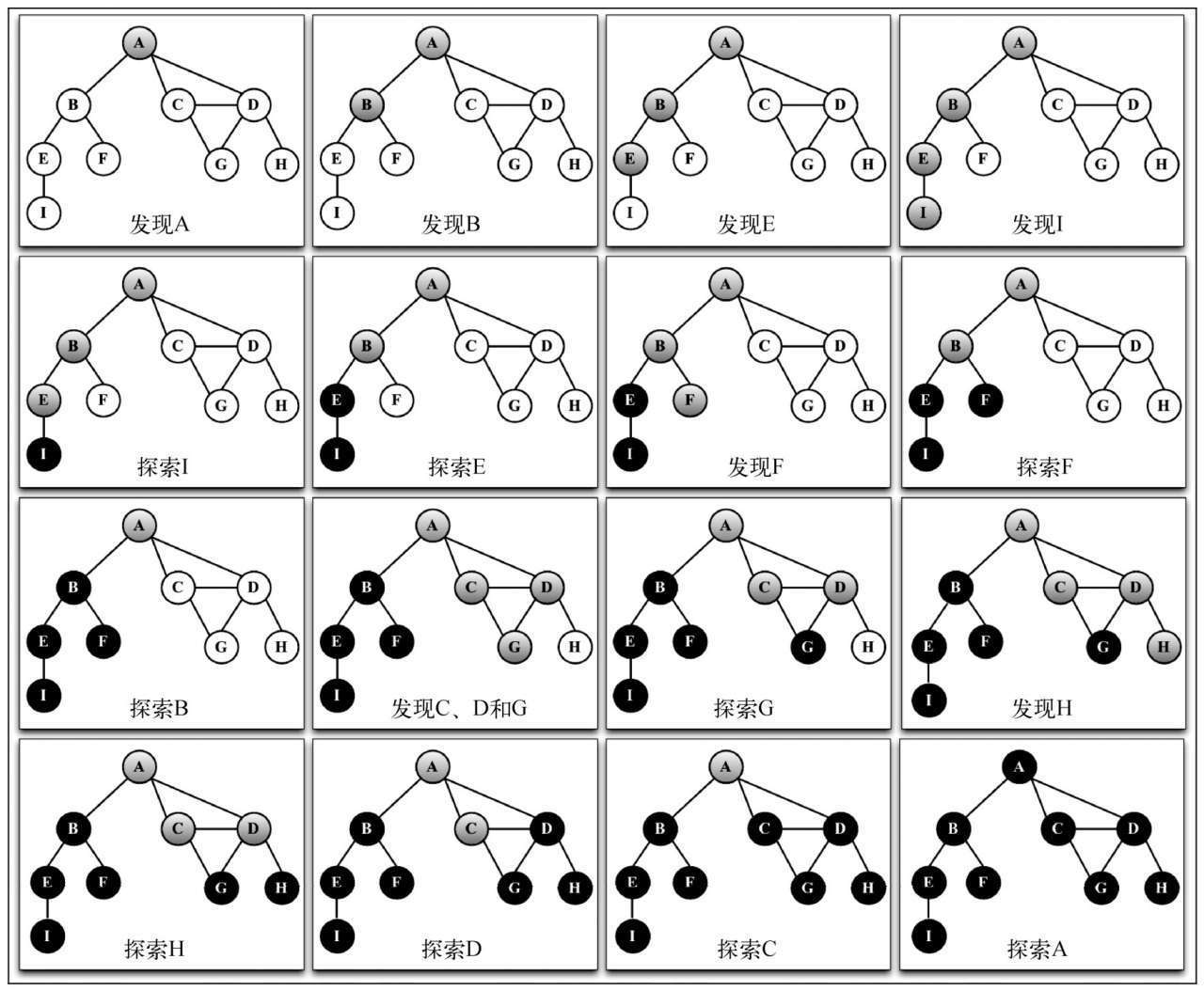# 图(Graph)
图是一种非线性数据结构。它的表示有以下几种:
# 邻接矩阵
邻接矩阵是表示图的常用方法, 用二维数组来表示, 数组的每个下标对应每个点。
当两个点有连线则二维数组的值为 1, 否则二维数组的值为 0。但是这种表示方法会照成存储空间的浪费(因存在大量 0)。
如果索引为i的节点和索引为j的节点相邻,则array[i][j] === 1,否则array[i][j] === 0
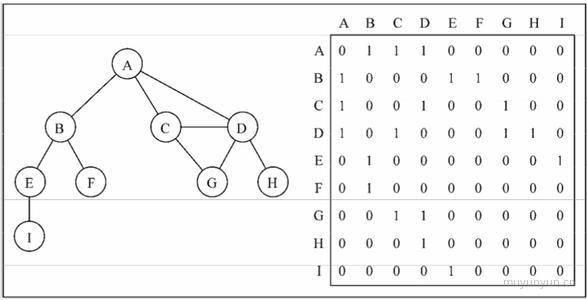
# 邻接表
左侧为存储的顶点, 右侧为与之想对应的点, 后文会采用这种方式实现图。
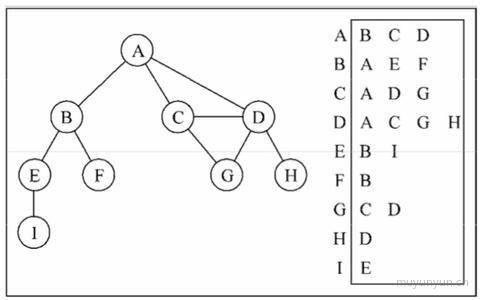
# 关联矩阵
行表示点, 列表示边。关联矩阵通常用于边的数量比顶点多的情况,以节省空间和内存。
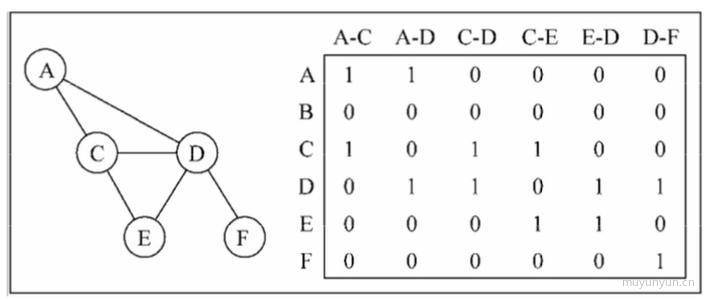
# 实现
class Graph {
constructor() {
this.vertices = [] // 存储顶点
this.adjList = new Map() // 存储边
}
// 添加顶点
addVertex(v) {
if (!this.vertices.includes(v)) {
this.vertices.push(v)
this.adjList.set(v, [])
}
}
// 往指定的点添加相邻的点
addEdge(v, w) {
// 验证顶点是否存在于图中
if (!this.adjList.get(v)) {
this.addVertex(v)
}
if (!this.adjList.get(w)) {
this.addVertex(w)
}
this.adjList.get(v).push(w)
this.adjList.get(w).push(v)
}
log() {
let str = ''
let neighbors
for (let i = 0; i < this.vertices.length; i++) {
str += `${this.vertices[i]} -> `
neighbors = this.adjList.get(this.vertices[i]).join(' ')
str += neighbors + '\n'
}
return str
}
}
按之前邻接表的图示, 跑如下测试用例:
const graph = new Graph()
var topArr = ['A', 'B', 'C', 'D', 'E', 'F', 'G', 'H', 'I']
for (let i of topArr) {
graph.addVertex(i)
}
graph.addEdge('A', 'B')
graph.addEdge('A', 'C')
graph.addEdge('A', 'D')
graph.addEdge('B', 'E')
graph.addEdge('B', 'F')
graph.addEdge('C', 'D')
graph.addEdge('C', 'G')
graph.addEdge('D', 'G')
graph.addEdge('D', 'H')
graph.addEdge('E', 'I')
console.log(graph.log())
// A -> B C D
// B -> A E F
// C -> A D G
// D -> A C G H
// E -> B I
// F -> B
// G -> C D
// H -> D
// I -> E
# 广度优先遍历
顾名思义, 广度优先即横向优先, 英文名为 breadth first search(BFS), 它示意图如下:
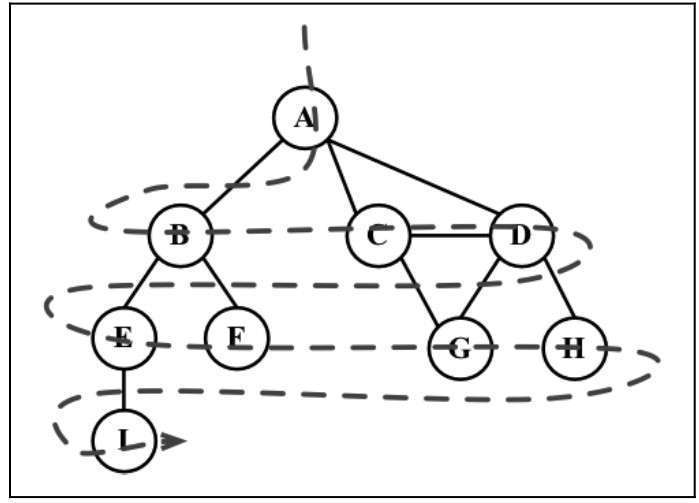
思想: 用到了队列的思想 (标白: 未发现; 标灰: 已找寻)
- 创建队列 u, 将标灰的顶点插入队列;
- 若队列 u 不为空;
- 从队列取出值 v;
- 将 v 的相邻节点标灰并插入队列 u;
bfs(v, callback) {
const obj = {}
const queue = new Queue()
for (let i of this.vertices) { // 初始化颜色
obj[i] = 'white'
}
obj[v] = 'red' // 已完成
queue.enqueue(v) // 搜索值先入栈
let shiftQueue, neighbour
while (!queue.empty()) {
shiftQueue = queue.dequeue()
neighbour = this.adjList.get(shiftQueue)
for (let i of neighbour) { // 循环相邻节点
if (obj[i] === 'white') { // 未完成的
obj[i] = 'red'
queue.enqueue(i)
}
}
if (callback) {
callback(shiftQueue)
}
}
}
graph.bfs('A', (e) => console.log(e))
graph.bfs('B', (e) => console.log(e))
// A B C D E F G H I
// B A E F C D I G H
# 广度优先遍历求最短路径
在上述 bfs 函数实现的基础上, 加入两个变量分别存储距离以及最短路径上先前的点
BFS(v) {
const obj = {}
const queue = new Queue()
const distance = {} // 距离
const prev = {} // 前溯点
for (let i of this.vertices) { // 初始化颜色
obj[i] = 'white'
distance[i] = 0
prev[i] = null
}
obj[v] = 'red' // 搜索值
queue.enqueue(v) // 入栈
let shiftQueue, neighbour
while (!queue.empty()) {
shiftQueue = queue.dequeue()
neighbour = this.adjList.get(shiftQueue)
for (let i of neighbour) {
if (obj[i] === 'white') {
obj[i] = 'red'
queue.enqueue(i)
// 第二行的点距离第一行的点相差为 1, 第三行的点距离第二行的点相差为 1, 以此类推。
// shiftQueue 是 i 的前溯点 (上一级的节点)
distance[i] = distance[shiftQueue] + 1
prev[i] = shiftQueue
}
}
}
return {
distance,
prev
}
}
logMinPath(v) {
const { distance, prev } = this.BFS(v)
let path = ''
const arr = []
Object.keys(distance).map(r => {
path = r
while (prev[r]) { // 终止条件为 prev 中值为 null 时
path = prev[r] + ' - ' + path
r = prev[r]
}
arr.push(path)
})
return arr.join('\n')
}
console.log(graph.BFS('A'))
// A
// A - B
// A - C
// A - D
// A - B - E
// A - B - F
// A - C - G
// A - D - H
// A - B - E - I
# 深度优先遍历
深度优先遍历用到了栈的思想。英文名为 depth first search(DFS), 其示意图如下:
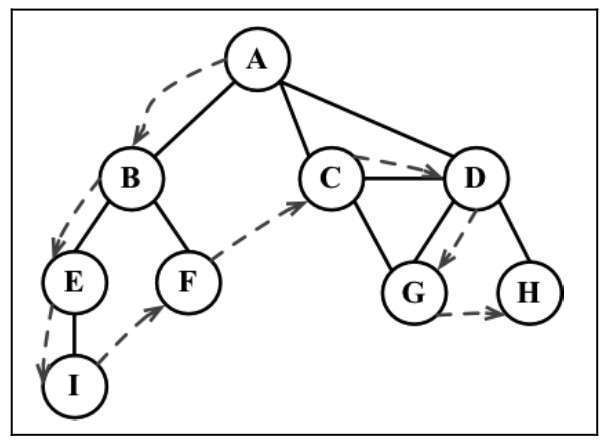
dfs(v, cb) {
const obj = {}
for (let i of this.vertices) { // 初始化颜色
obj[i] = 'white'
}
const find = (v, color, cb) => {
color[v] = 'red'
if (cb) {
cb(v)
}
let neighbour = this.adjList.get(v)
for (let i of neighbour) { // v的所有邻点列表
if (color[i] === 'white') { // 未访问过的
find(i, color, cb)
}
}
}
find(v, obj, cb)
}
let str = ''
graph.dfs('A', (e) => str += ' ' + e )
console.log(str)
// A B E I F C D G H
下面这个示意图展示了该算法每一步的执行过程。
